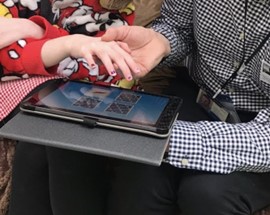Steve Wiseman Associates (SWA) received a referral for a 14-year-old girl whose engagement levels, communication and concentration was severely restricted by her levels of autism. She did not engage well with therapy and in most cases would not tolerate the presence of therapists in her home. Her parent and the speech and language therapist (SLT) already involved in this case felt that assistive technology could play a significant role in her rehabilitation and independence.
During our initial assessment visit, made jointly with the SLT, Elise was able to tolerate the presence of the SWA practitioner for only 15 minutes. Nonetheless, this was deemed to be a success and our recommendations for longer term intervention were accepted.
Successful Strategies to Improve Engagement Levels
SWA practitioners always work towards clearly defined goals. In this case our initial very clear goals, agreed with the case manager and SLT, were to build rapport, gain Elise’s trust and secure improved levels of engagement. If achieved, this would enable the gradual introduction of a wider range of effective interventions. Strategies included:
Monitoring and Measuring Engagement Levels
The Testing and Standards Agency Engagement Model was used to help the practitioners analyse engagement levels and identify the most successful elements of intervention. This model breaks down engagement levels into categories which include exploration, realisation, anticipation, persistence and initiation. Consideration of these elements after each therapy session helped to inform the content of delivery of future sessions.
Communication and Negotiation
Use of communication symbols and a ‘Now and Next’ board helped Elise to negotiate and anticipate the activities that were going to take place during therapy sessions. Promoting choice and control has been a key element in securing Elise’s trust and extending her engagement levels.

Hi-tech, Lo-tech or No tech?
Combining technology with low tech activities and resources helped to establish a familiar routine during therapy sessions and provide comforting, familiar, fun introductions to more challenging therapeutic activities. Using a laptop or iPad to develop concentration, dexterity, touch screen skills, and provide entertainment, was often preceded with colouring or simple tactile or sensory toys.


Benefits of Joint Working
Over the weeks and months that followed, all the visits made by the SLT and assistive technologist were conducted jointly at both school and home. A number of advantages of this kind of joint working have become very clear:
Mutual Support
Success was limited during initial sessions, but both practitioners were able to support each other and engage in joint analysis of sessions to achieve improvements in the delivery of interventions. This resulted in an improvement in outcomes. Joint facilitation and observation generated valuable information from different viewpoints (both professional and physical).
Joint Planning
There is always a need to plan sessions carefully, select effective resources, and utilise a variety of different delivery methods. In this challenging situation, both practitioners were agreed that ‘two heads are better than one’. Expertise which spans across more than one discipline can be very effective with clients who are challenged by engagement difficulties.
Effective Delivery of Intervention
The two practitioners, being familiar with each other’s working methods and skill sets, were able to offer very effective delivery of intervention because they were able to facilitate frequent changes of pace, use a wider variety of resources and activities, provide higher levels of interaction, and gain more effective analysis of results. Because Elise was difficult to engage, at least during the initial sessions, having a ‘Plan B’ for each activity was essential.
One powerful strategy was to model turn taking, allowing the client to enjoy ‘input’ reducing the expectation for her to produce any ‘output’ and making it almost irresistible for her to join in eventually, despite her barriers to engagement. This was about her learning to engage, and it proved to be very effective.
Joint working also provided an opportunity to take photographs and video clips. This assisted with session evaluation and provided evidence for the legal team.
Safety
There were some unique factors in this case which increased the risk to personal safety for both the client and practitioners. Conducting a session alone was not advisable, and having the opportunity to conduct and record joint risk assessments was a very clear benefit.
Results
Elise has now reached the stage where she will engage in joint therapy sessions with the SLT and assistive technologist for more than an hour. She displays clear signs of being motivated to engage and enjoying therapeutic activities.
At home, through the very careful selection and sensitive introduction of assistive technology she is now able to enjoy greater levels of independence, more control over her environment and more choice of her leisure activities. For example, through the use of the Amazon Echo Show she is able to have control over her lighting, request music, and choose and control videos independently. Prior to this she would ask her parents to turn lights, and TV on and off how to control a DVD player. This success alone was labelled a ‘game changer’ by her parent.



